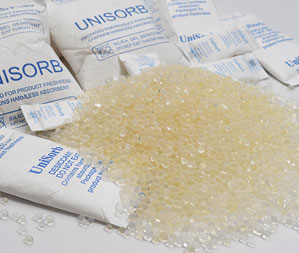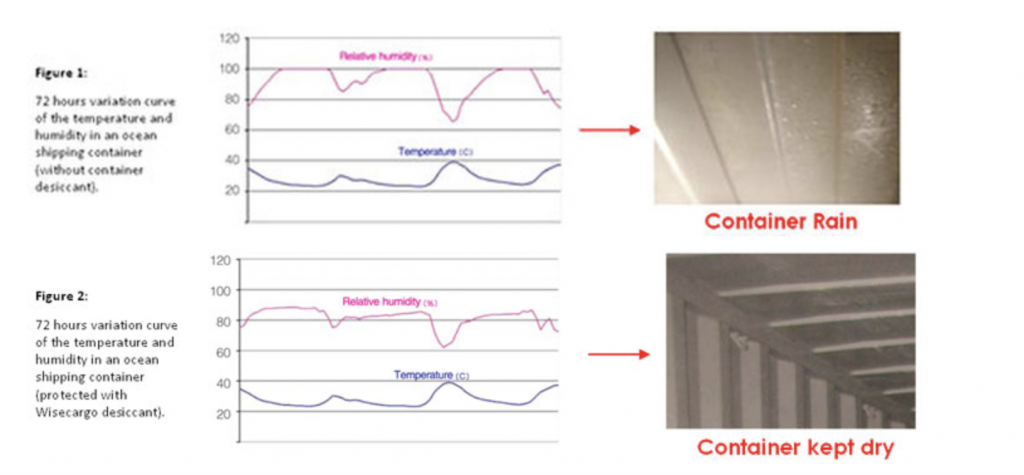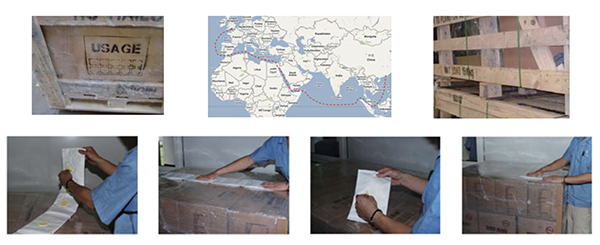Wisecargo Gel Desiccant from JMP is the Rolls Royce of desiccants at a Toyota price! Wisecargo is a technological break through in desiccants and is available in New Zealand exclusively through JMP Holdings. They take out 280% of absorption.

Wisecargo is a specially designed desiccant housed inside leak proof packaging. It is an important tool in assuring your cargo is transported in a dry and safe condition no matter what temperature extremities it may endure. Wisecargo quickly absorbs large amounts of moisture in order to control the relative humidity inside a shipping container, effectively wiping out the problem of ‘container rain’ caused by this excessive humidity.
Wisecargo’s sorbent is a unique formula, which can absorb up to 280% of its weight under the condition of 25°C and 90% humidity. With such a large absorption rate the sorbent turns into a leak proof gel for added product protection.
When containers are loaded and shipped through fluctuating temperatures and relative humidity the possibility of condensation occurring is substantial as temperatures drop. Wisecargo helps keep the dew point temperature below the actual temperature, even when the actual temperature drops within the shipping container due to fluctuations. “Dew Point Temperature” is the temperature at which water vapor begins to condense onto a surface forming liquid water. The liquid that results inside a container is called “Container Rain”.
Container rain will occur if the surface temperature of an object is equal or lower than the dew point temperature. If the relative humidity is lowered with the absorbing properties of Wisecargo, the dew point temperature is also lowered, stopping container rain.
As you can see from the two charts below, the use of Wisecargo has helped bring the relative humidity down far below 100%.

Wisecargo Gel Desiccant Size 4 × 125g Strip
Suited for usage in 20 and 40 foot containers. Ideal for protection of canned goods, glass paper, cardboard, packed flour, canned pet food and cheese, milk in cartons, agricultural products (i.e. Hay), horse feed, leather products, any cartoned packaging, pharmaceuticals etc.
Designed with adhesive backing for quicker installation!
A typical cycle is therefore:
- As the temperature rises in a container, the enclosed air draws moisture from all possible sources inside the container, i.e. the wooden floor, pallets, product packaging and even the product itself.
- Then as the temperature drops, i.e. during the night, during atmospheric changes, or when the ship moves into a colder climate, the moisture is released and condenses on the container’s roof and sides.
- The water that drips from the roof of the container, together with the condensation that forms on the product causes corrosion, mould, caking of powders, and damage to labels and packaging.
- This process of warming and cooling repeats itself numerous times during a voyage, causing the damaging moisture cycle to repeat itself.
How do Wisecargo Desiccants work?
- Wisecargo desiccants are manufactured under controlled conditions in order to assure you of an absolutely dry desiccant upon delivery.
- After your container has been packed, and the specially formulated film enclosing the Wisecargobag removed, the desiccant will immediately start to absorb any moisture present inside the container.
- On the container doors being closed, Wisecargo controls the humidity inside the container by continuously absorbing the moisture from the enclosed air within. Wisecargo is designed to hold the moisture and not release it back into the container’s climate.
- As the humidity inside the container is kept continuously low, the air is dry enough to prevent condensation forming at low temperatures.
- Wisecargo will continue to absorb the moisture until it has gained approximately 280% of its own weight.
Positioning your Wisecargo Desiccants
Placing your Wisecargo in strategic positions inside your container should ensure a dry cargo out turn at the final destination. Wisecargo strips are very flexible and come with adhesive backing tabs allowing you to place the bag in almost any position no matter what the packing configuration of the container maybe.

Case Study Brief for Wisecargo Gel Desiccant
Company ‘A’ ships their product by ocean freight container from South China to the United Kingdom. When the container is opened at the destination water beads are found along the surface of the container’s roof. The cartons were damp and there was an unpleasant odour omitting from a build up of mould on the wooden cases (see below). A solution had to be sought and that solution was Wisecargo. To ensure Wisecargo was the perfect choice a trial was conducted.
Shipping Conditions
- July 26th – Container is loaded.
- August 7th – Container transported to wharf in South China.
- August 8th – Container departs China for United Kingdom.
- September 5th – Container arrives at inland UK destination.
Trial Method
- 28 wooden cases loaded into a 40′ container. 8 pieces of 1.5kg Wisecargo positioned on top of the wooden cases.
- Desiccants were also placed inside the wooden cases to add further protection to the goods.
- Two temperature and humidity data loggers were strategically placed inside the container. One was inside the goods and one placed on the outside of the goods.
Trial Results
- No condensation appeared in any part of the container.
- No water trail was found in any parts of the product or wooden cases.
- The desiccants were not broken, damp or in any abnornmal appearance.
Analysis and Research
- The relative humidity inside of the product package was basically kept between 70–80%, which protects the cargo adequately.
- The relative humidity in the container was also basically kept at about 80% by the Wisecargo, preventing any appearance of container rain.
Conclusion
Using the correct amount of Wisecargo desiccants inside a shipping container will ensure your product and your reputation stays protected. Wisecargo desiccants should be placed as high as possible in a container and secured firmly.
